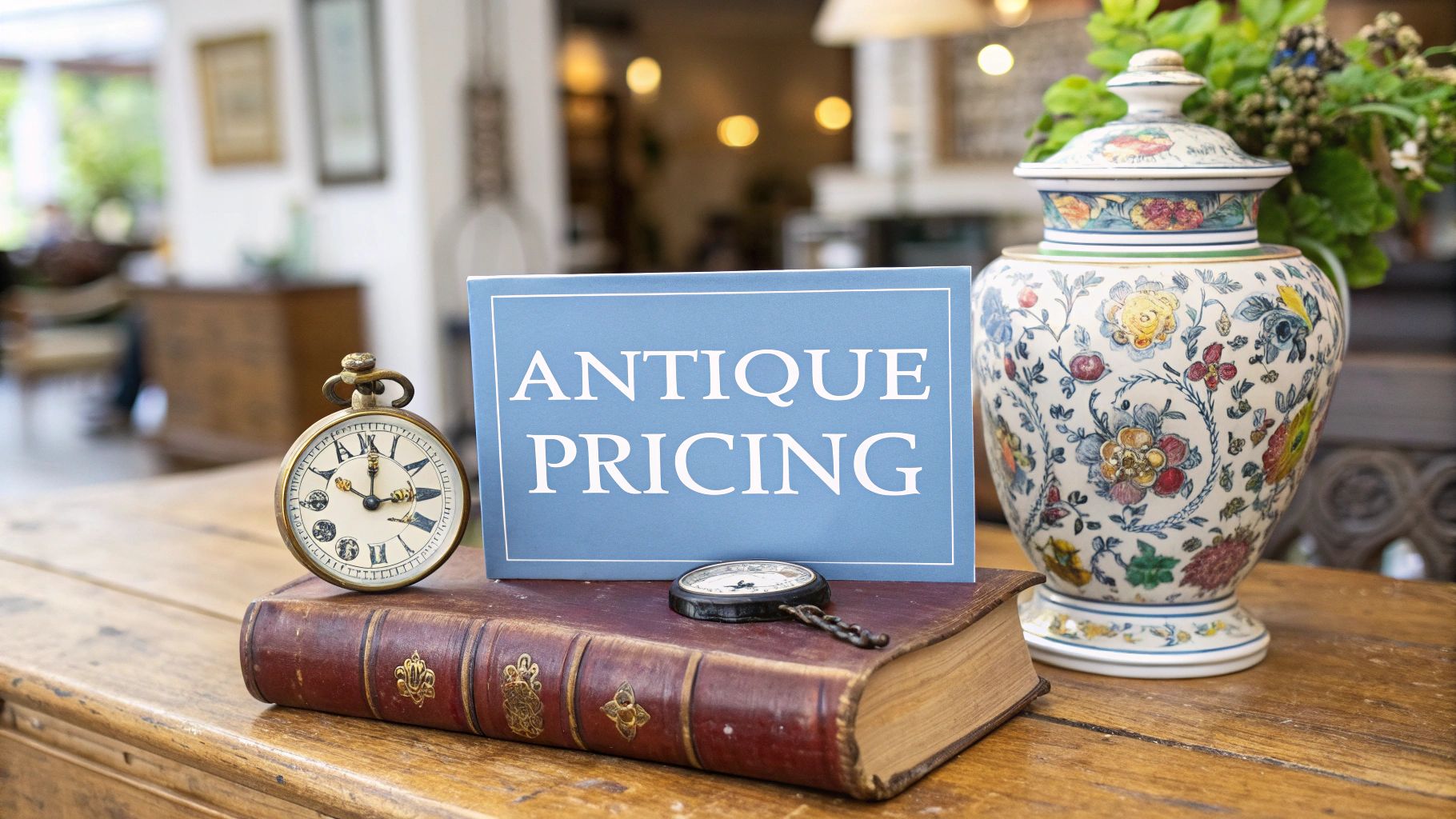Figuring out what an antique is worth can feel like a guessing game. But for seasoned collectors and dealers, it's a methodical process—one you can learn, too. The key is moving past gut feelings and building a consistent framework to evaluate any piece you come across.
Your Framework for Pricing Antiques
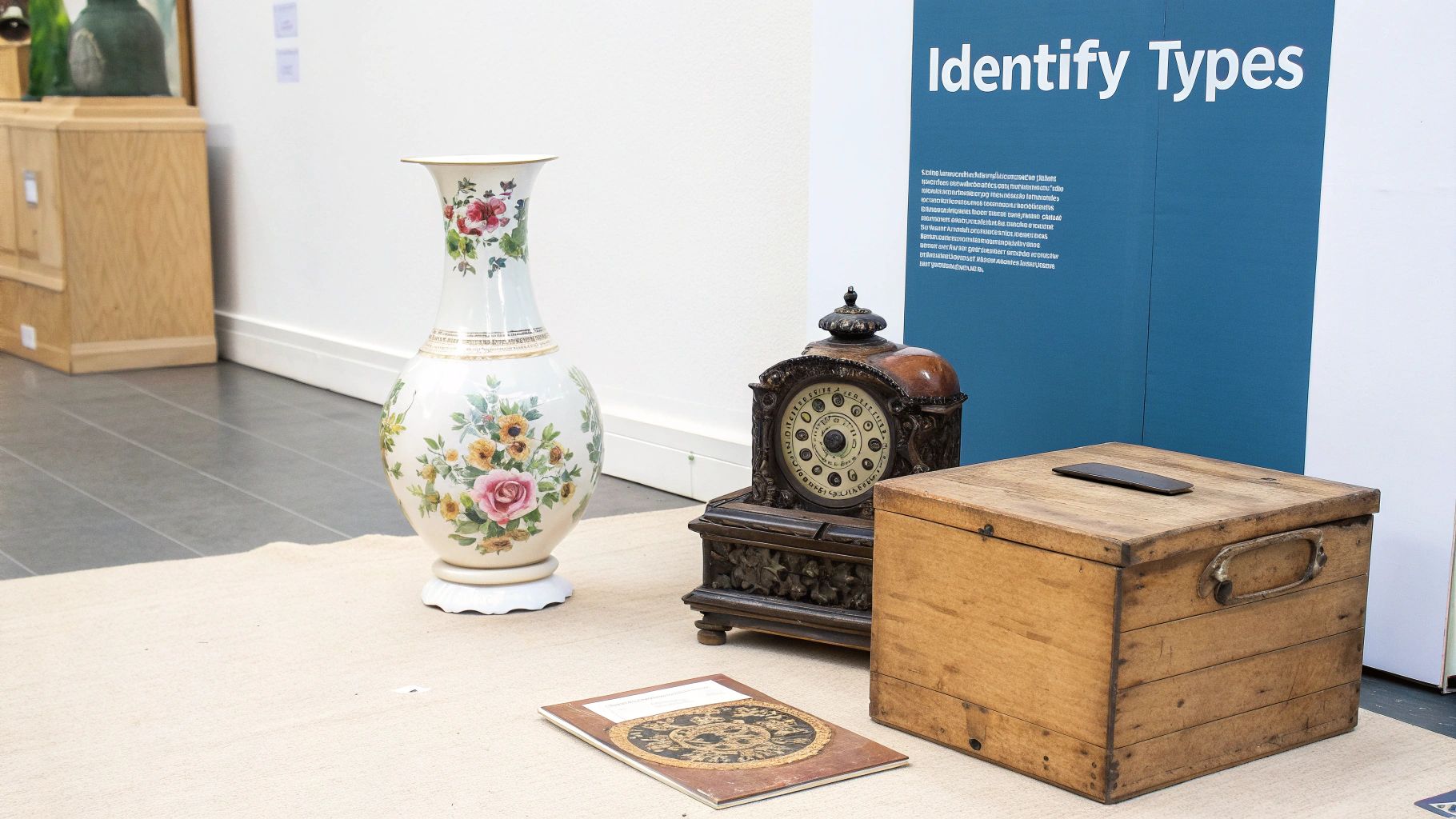
Before you can even think about a price tag, you have to understand what gives an item value in the first place. It's not about memorizing auction prices. It's about developing an eye for what makes one piece a treasure and another just old stuff.
This whole process feels a lot less overwhelming when you break it down. Professionals do this every day, whether they're digging through an estate sale or appraising a museum piece. They rely on four core pillars to build a complete picture of an item's worth, removing emotion from the equation and focusing on what the market truly values.
The Four Pillars of Value
Think of these four elements as the legs of a stool—if one is shaky, the whole thing might topple. You need to consider each one to land on a realistic price.
- Authenticity: First things first, is this piece what it claims to be? This is where you play detective, looking for maker's marks, specific construction styles, and period-correct materials to confirm its age and origin.
- Condition: How has the item held up over the years? Be honest about any damage, repairs, or even just general wear and tear. The condition can be a massive value driver, sometimes swinging the price by over 50%.
- Rarity: How many of these are out there? An item could be a rare find because few were made, most didn't survive, or it was crafted by a brilliant artisan who wasn't very prolific.
- Provenance: What's the story behind it? A documented ownership history, especially one tied to a famous person or a well-known collection, can add a serious premium to the price.
To give you a clearer picture, here's a simple breakdown of these core factors.
Core Factors Influencing Antique Value
| Valuation Factor | What It Means | Why It Matters for Pricing |
|---|---|---|
| Authenticity | Verifying the item's age, creator, and origin. | A genuine piece is always worth more than a reproduction or fake. |
| Condition | The physical state, including any damage, repairs, or wear. | Pristine items command top dollar; damage drastically cuts value. |
| Rarity | How common or scarce the item is. | Fewer available items mean higher demand and a higher price. |
| Provenance | The documented history of ownership. | A compelling story or famous owner adds historical and monetary value. |
Mastering these four pillars is the foundation of any solid appraisal. For an even more detailed walkthrough, you can explore our full antique valuation guide.
Why a Solid Framework Is Non-Negotiable
This methodical approach isn't just good practice; it's essential in today's market. The global antiques trade is a serious business, generating an estimated USD 58.4 billion in 2024. That market is fueled by discerning collectors who want authenticity and history, so pricing accurately is critical for anyone looking to buy or sell.
By consistently applying this framework, you move from being a casual enthusiast to a knowledgeable evaluator. It’s about building confidence in your ability to see an antique not just for what it is, but for what it’s truly worth.
Getting a Feel for Condition and Authenticity
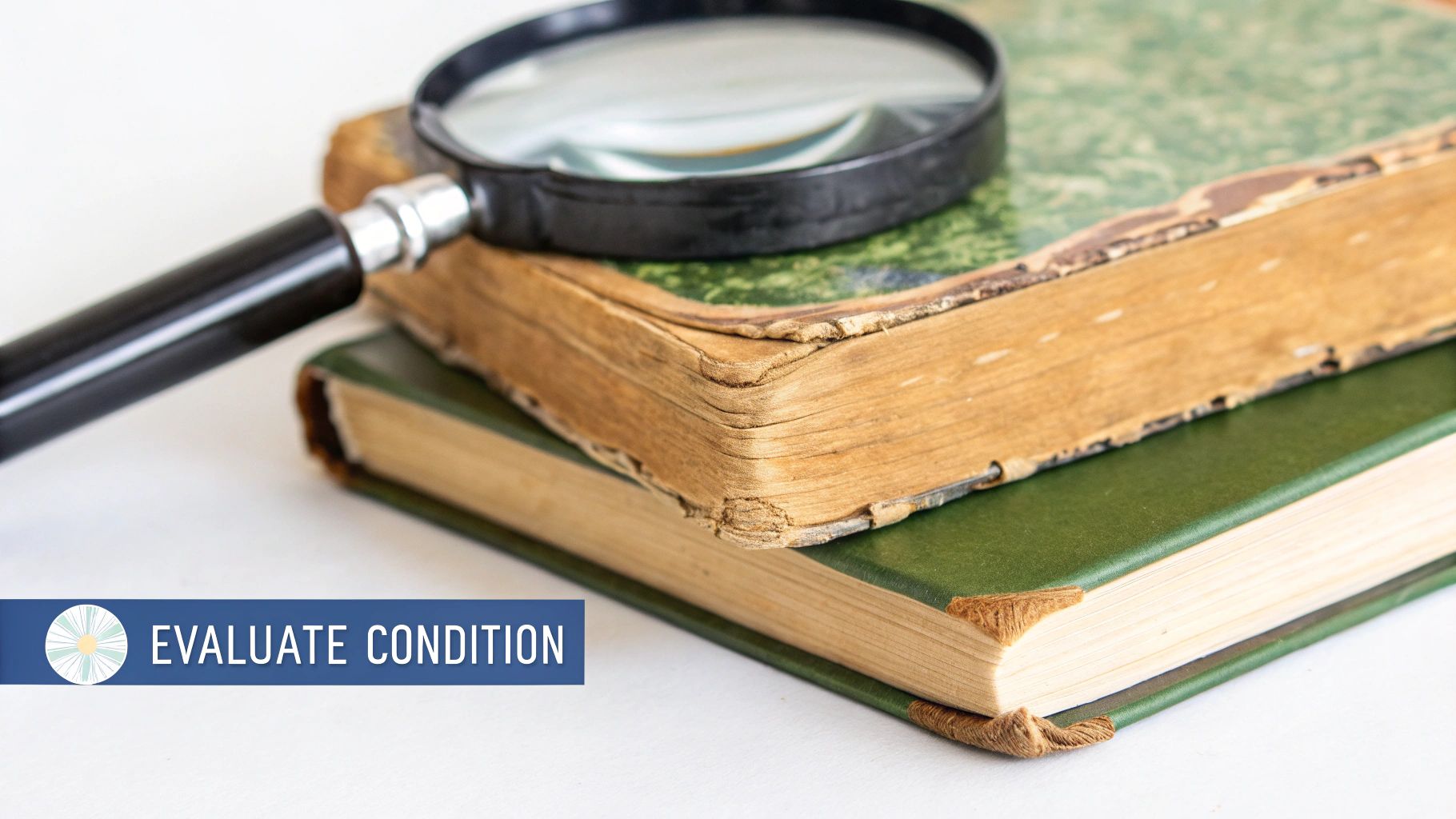
Alright, you've got your starting point. Now it’s time to get your hands dirty and look at your item with a critical eye. This is where the rubber meets the road, because the physical state of an antique is a huge deal. Seriously. Poor condition can easily slash an item's market value by 50% or more, turning a potential gem into little more than a project piece.
This part of the process is about moving beyond a quick glance. You'll learn to see the difference between the gentle patina of age—something collectors often love—and the kind of damage that torpedoes your valuation.
Telling Honest Wear Apart from Damage
Every old piece has a story to tell, and a lot of that story is written on its surface. The thing is, not all signs of age are bad. That subtle darkening on old pine furniture or the soft, worn corners of a first-edition book are often seen as beautiful markers of authenticity. The trick is spotting the difference between this "honest wear" and actual, value-killing damage.
Think about a Victorian armchair. One might have its original velvet upholstery, a bit faded but still intact. That's desirable. Another could have been hastily reupholstered in a cheap, modern fabric that just looks wrong. That doesn't add value; it takes it away.
A classic mistake is thinking any old thing is valuable just because it's old. The truth is, collectors pay top dollar for pieces that have been babied their whole lives. A chip on a teacup or a deep scratch across a tabletop isn't just a cosmetic issue—it's a direct hit to the final price.
Start by examining the item in bright, natural light if you can. You’re hunting for anything that hurts its structural integrity or visual appeal.
- Cracks and Chips: These are killer for glass and ceramics. Even a tiny hairline crack can devastate the value of a piece of porcelain.
- Repairs: Get up close and look for tell-tale signs of glue, mismatched paint, or modern hardware. See Philips head screws on a piece that should have old flatheads? That's a red flag.
- Stains and Discoloration: Those white water rings on a wood table or deep-set stains on old linens can be nearly impossible to fix.
- Missing Parts: An ornate dresser without its original brass pulls or a clock that's lost its pendulum is incomplete. Its value will absolutely reflect that.
Practical Tips for a Thorough Inspection
Your phone's flashlight is a decent starting point, but a few simple tools can help you uncover hidden secrets. A basic magnifying glass is great for tiny details, and you might be surprised by how useful a blacklight can be.
A blacklight, for example, is a secret weapon for checking ceramics and porcelain. Shine it on a piece in a dark room. Modern glues and paints used in repairs will often glow—usually a bright white or purple—instantly revealing a restoration that you'd never spot with the naked eye. This simple trick can save you from overvaluing a cleverly mended vase.
When you’re looking at furniture, get down and inspect the joinery. Authentic antique pieces will often have dovetail joints (those interlocking trapezoid shapes) or sturdy mortise and tenon joints. If you see staples, modern glues, or perfectly uniform, machine-cut joints, you might be looking at a reproduction or a heavily altered piece.
Hunting for the Maker's Signature
Authenticity is the absolute foundation of value. One of the best ways to get a handle on an item's age and origin is to find a maker's mark, a signature, or a company stamp. You'll have to hunt for them—they're often hidden on the bottom of pottery, inside a drawer, or along the edge of a silver fork.
Think of these marks as a signature from the past. They connect your item to a specific craftsman, factory, or time period. Finding a "T. & R. Boote" mark on a piece of ironstone, for instance, tells you it was likely made in England around the 1860s. That one detail gives you a fantastic launchpad for your research.
Sometimes these marks are faint or worn. Take a clear, well-lit photo of it. You can use online resources or even identification apps like Curio to figure out what you're looking at. Even a partial mark is often enough to point you in the right direction. Once you nail down the maker, you can start digging into their reputation and how sought-after their work is—all key information for finding what your piece is truly worth.
So, What Are Similar Antiques Actually Selling For?
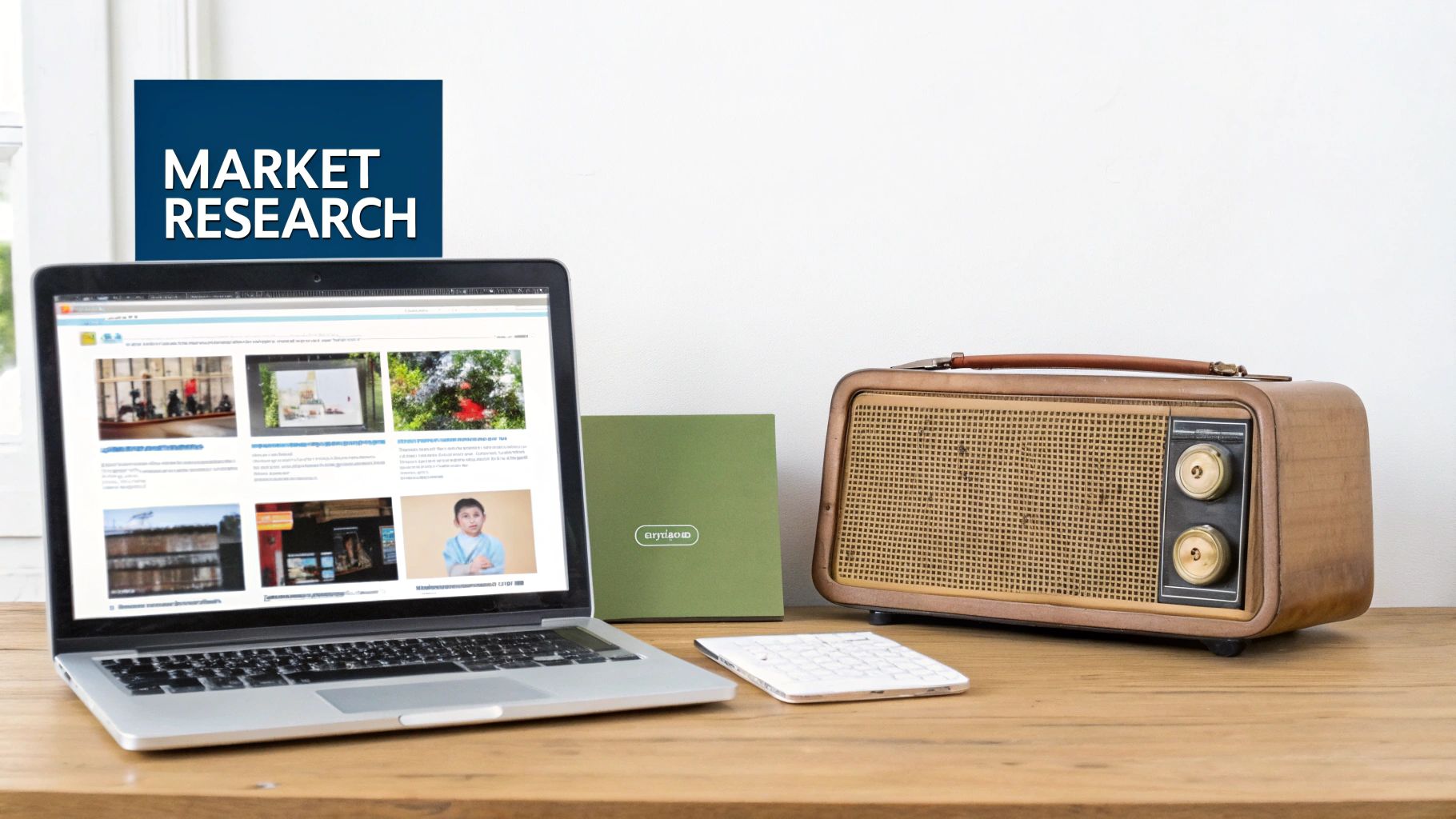
Okay, you’ve figured out what your piece is and what shape it’s in. That’s half the battle. Now comes the real detective work: finding out what people have actually paid for items just like yours. This is where you ground your expectations in reality, not just wishful thinking.
Your mission is to find "comparables"—or "comps," as we call them in the business. These are items nearly identical to yours that have sold recently. This tells you what real buyers were willing to pay, which is infinitely more useful than an ambitious price tag you see on a dealer's website.
Asking Price vs. Sold Price: The Only Number That Matters
When you start digging, you'll see two kinds of prices. There's the asking price (what a seller hopes to get) and the sold price (what a buyer actually paid). You need to ignore the former and focus exclusively on the latter.
It's easy to get excited when you see an antique just like yours listed for $500. But that piece might have been sitting online for years, or it might have eventually sold for a "best offer" of $300. The final, realized price is the only number that tells the true story of its market value.
Never base your price on what others are asking. The most reliable data comes from completed transactions. This distinction is the bedrock of building a realistic and effective pricing strategy.
Your Go-To Online Research Tools
The best place to find this data is in online databases that track auction results. Think of them as a treasure trove of sales records, giving you a transparent peek into the market.
Top Resources for Finding Sold Prices
- Auction House Databases: Sites like LiveAuctioneers and Invaluable are fantastic. They compile results from countless auction houses, and you can usually search their past results for free.
- eBay's Sold Listings: This is a powerhouse for everyday antiques and collectibles. Just search for your item, then on the results page, find the filter for "Sold Items." This shows you real-world sales data from the past 90 days.
- Niche Collector Sites: For very specific categories, like a certain pattern of ironstone or a particular furniture maker, you'll often find dedicated collector websites with their own price guides and sales histories.
As you dive in, try to think like a buyer who's searching for your exact piece. If you'd like a broader look at the different ways to approach this, our guide on how to value antiques offers some extra context that can help you sharpen your research skills.
How to Search Smarter, Not Harder
The quality of your research hinges on your search terms. Start specific, but don't be afraid to zoom out if you aren't finding anything.
Let's imagine you have a white ironstone pitcher made by T. & R. Boote. I'd approach the search in a few stages:
- Start narrow: "T&R Boote ironstone pitcher"
- Broaden the form: "T&R Boote ironstone tureen" (This helps you see what other hollowware from the same maker is selling for.)
- Broaden the maker: "English white ironstone pitcher"
- Broaden the style: "Victorian ironstone pitcher"
This tiered method helps you paint a complete picture. You might discover that while your exact pitcher hasn't sold recently, a very similar one from another English maker of the same era went for $75. That’s a solid comparable.
Real-World Example: Finding Comps for a Chair
Let's say you picked up a walnut armchair from the 1960s. It has its original upholstery and a "Heywood-Wakefield" label.
- Your first search:
Heywood-Wakefield walnut armchair - The problem: You find a few, but they’re all over the place. Some are refinished, and others are a totally different style. Yours is in good, original condition, but it's not perfect.
- Refine your search: Go to eBay and search
Heywood-Wakefield armchair original, making sure to filter by "Sold" listings. - The results: You find three good matches that sold recently. One in mint condition sold for $450. Another with visibly worn upholstery went for $220. A third, with a small but noticeable stain, sold for $150.
Suddenly, you have a clear, realistic price range. Knowing your chair is in good shape with only minor wear, you can confidently price it around $250, placing it right where it belongs in the market. By gathering a few solid data points, you've moved from guessing to making an informed decision backed by real evidence.
Uncovering an Antique's Rarity and Provenance
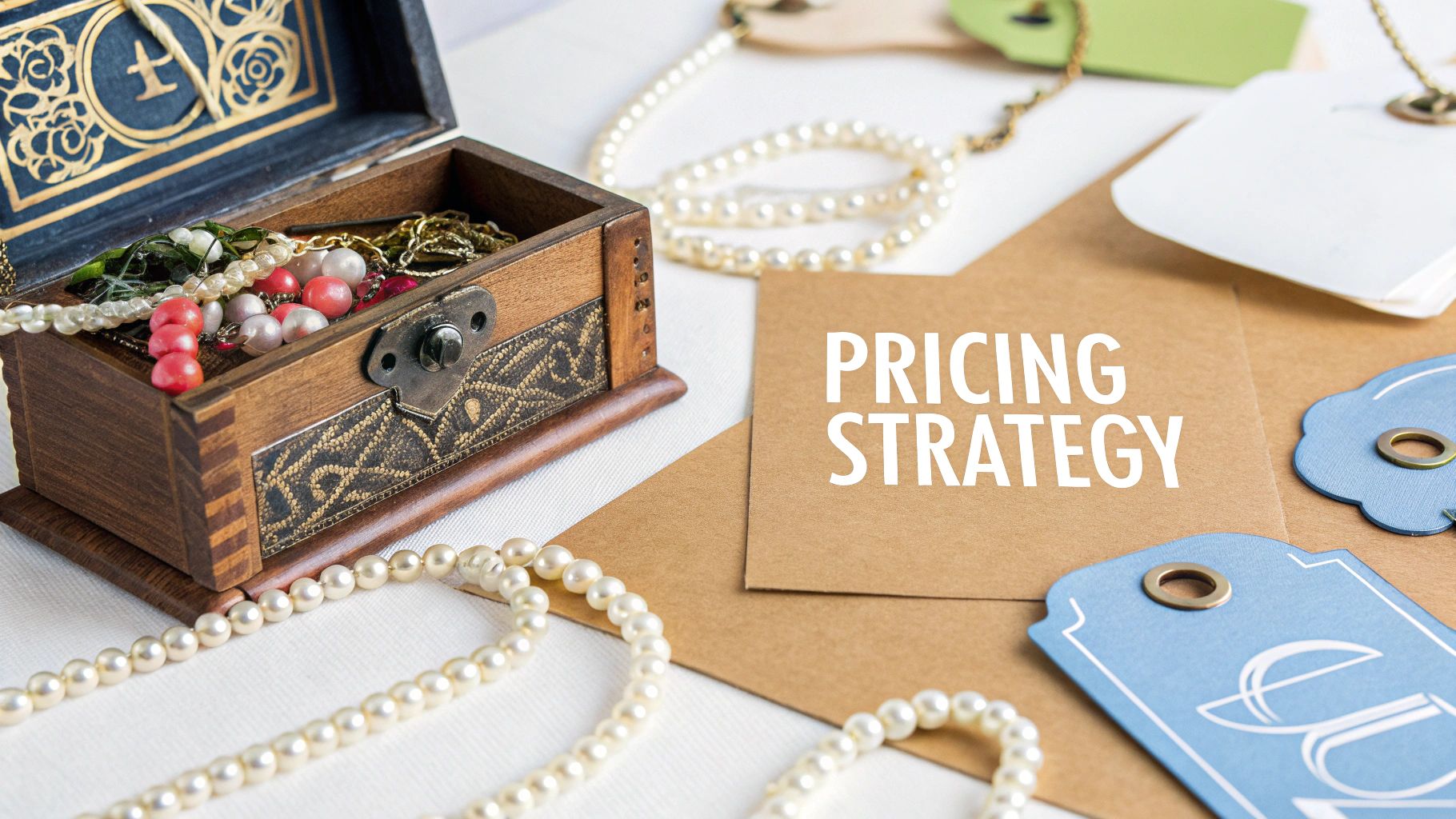
You've looked at the condition and you've found some comparable sales. But what separates an old chair worth $200 from a nearly identical one that commands $2,000? The answer often lies in two of the most thrilling factors in the antiques world: rarity and provenance.
These are the elements that can transform a nice old object into a genuine piece of history. While comps and condition give you a solid baseline, rarity and provenance are what can make an item’s value soar. This is where the real treasure hunt begins.
What Actually Makes an Antique Rare?
Let's get one thing straight: old doesn't automatically mean rare. Plenty of items were mass-produced a century ago and are still easy to find. Real rarity is about genuine scarcity, and it happens for a few key reasons.
- Limited Production: Was the piece a one-off commission or made by a small artisan studio? Maybe it was part of a limited edition. The fewer that were originally made, the more prized each survivor becomes.
- Fragility and Use (High Attrition): Some things were never built to last. Think about children’s toys, delicate glassware, or early paper ephemera. Most were used up, broken, and tossed, making any surviving examples incredibly scarce.
- A Famous Maker: An item designed by a celebrated name—like a chair by Charles and Ray Eames or pottery by Clarice Cliff—has rarity built-in. Their work is well-documented and avidly pursued by dedicated collectors.
Picture two similar Victorian ironstone pitchers. One came from a massive factory that churned out thousands. The other was made by a small pottery that was only in business for a couple of years. Even if they look almost the same, the one with the rarer maker’s mark will nearly always fetch a higher price.
One of the biggest lessons in pricing antiques is that rarity is relative. An item might be common in its country of origin but almost unheard of elsewhere. You have to dig into its production history to understand what you truly have.
The Power of a Story: What is Provenance?
If rarity is about how many of an item exist, provenance is the life story of your specific item. It’s the documented chain of ownership that connects your piece to a person, place, or important event. It's the hard evidence that turns family stories into verifiable facts.
A solid provenance can add staggering value. A simple pocket watch is one thing; a pocket watch with original papers showing it belonged to a famous general is something else entirely. Provenance creates an emotional hook and a historical context that buyers will pay a significant premium for.
How to Dig for Provenance
Unearthing an item's history is the most exciting part of the job. It’s a bit of detective work, so put on your investigator's hat and start looking for clues.
Where to Start Your Hunt:
- Family Lore: If it's an heirloom, interview your relatives. Jot down every name, date, and story they can remember. Was it a wedding present? Did it travel with an ancestor from the old country?
- The Object Itself: Scour the item for inscriptions, monograms, labels, or even old repair marks. A name engraved on a locket or a bookplate inside a cover is a fantastic lead.
- Hidden Treasures: Never, ever throw away old letters, receipts, or photos you find with an antique. A faded photo showing the piece in a room or a letter mentioning its purchase is pure gold.
- Published History: Has the item ever appeared in a book, magazine, or old auction catalog? Exploring digital archives of past auctions can sometimes reveal a piece's sales history and previous ownership.
Imagine you have an old writing desk. On its own, it’s a nice piece of furniture. But if you discover a letter tucked away in a hidden drawer written by a well-known author, you've just struck provenance gold. That documented link transforms it from just a desk into "an author's desk," instantly boosting its importance—and its price.
How Technology Is Changing Antique Valuation
https://www.youtube.com/embed/NMkEyKvl75g
The classic image of an appraiser squinting through a loupe isn't going away, but it's certainly getting a modern upgrade. The once slow, painstaking process of pricing antiques is being supercharged by some powerful new tools that are fundamentally changing how we determine value, prove an item's history, and even find buyers.
If you're trying to price antiques today, ignoring these shifts is like trying to sail without a compass. These advancements are making the market more transparent and accessible than ever, whether you're a seasoned dealer or just trying to figure out what that inherited tea set is worth.
The Rise of AI-Powered Pricing
One of the biggest game-changers has been artificial intelligence. It might sound like something out of science fiction, but AI-powered tools are already a huge deal in the valuation world. Apps like Curio can crunch millions of data points from past auction results, online marketplaces, and dealer listings in just a few seconds.
This isn't just a glorified search engine. These systems are smart enough to spot market trends, identify subtle variations between similar pieces, and weigh factors like condition or a specific maker's mark to give you a data-backed price estimate. For a seller, this means getting a realistic starting point almost instantly, saving you hours of manual research.
By sifting through enormous amounts of data, AI strips away a lot of the guesswork and personal bias that can cloud pricing. It gives you a clear-eyed look at what an item is actually fetching in the current market, based on what real people are paying.
Think about it this way: you could spend a whole afternoon digging through sold listings on eBay for a particular ironstone pitcher. Or, you could have an AI tool instantly compare that pitcher to thousands of similar sales, giving you a much more confident and accurate price range from the get-go.
Blockchain and Building Buyer Trust
One of the oldest headaches in the antiques trade is proving an item's story—its provenance. This is where blockchain technology is starting to make some serious waves. It's essentially a tamper-proof digital ledger that can record an item's entire ownership history.
This technology is a game-changer for verifying an item's past, which is a huge factor in its value. It helps cut down on fraud and gives buyers the confidence they need to invest in a piece. For more on how tech is shaping the future of the market, you can find some great insights over at Mozer's Fine Antiques.
For a high-value piece, having its history permanently recorded on a blockchain adds a powerful layer of security and legitimacy. That security can absolutely justify a higher price tag.
Bringing the Showroom to the Buyer
Technology is also smashing geographical barriers. Gone are the days when you could only sell to local buyers. With high-resolution digital photography and 360-degree imaging, a collector in Tokyo can inspect an item in your shop in Toledo with incredible detail.
This is opening up the market in a few key ways:
- Incredible Detail: Buyers can zoom right in on maker's marks, see the texture of brushstrokes on a canvas, or spot a hairline crack on a piece of porcelain from halfway around the world.
- Virtual Reality (VR): Some high-end galleries and auction houses are even building VR showrooms. Imagine a collector putting on a headset and "walking" through your collection, viewing pieces as if they were standing right there.
- A Global Audience: This level of access means you're no longer limited to foot traffic. You can market a rare find to a worldwide audience of collectors, which naturally creates more competition and can drive the final price up.
Knowing how to use these tools is no longer just a nice bonus—it's becoming essential for anyone who wants to price and sell antiques successfully. They give you the data, the trust, and the global reach you need to thrive.
Setting Your Final Price with Confidence
This is where all your hard work comes together. You’ve scrutinized every detail of your item's condition, tracked down solid comparables, and uncovered its unique history. Now, it's time to turn all that valuable information into a single, justifiable price. Think of it as part art, part science—blending hard data with a smart sales strategy.
Your final price isn't a one-size-fits-all number. The right price tag depends entirely on where you plan to sell. The figure you land on for a quick online sale will look very different from what you'd ask at a high-end antique mall or what you’d hope to achieve at auction.
Match Your Price to the Platform
First, think about your buyer and the sales environment. Are you setting up at a busy flea market where a friendly haggle is expected? Or are you listing on a specialized online platform where buyers demand well-researched, firm prices? Each venue has its own unwritten rules.
- Online Marketplaces (like eBay or Etsy): On these sites, your price has to be competitive. Buyers are actively comparing your item against dozens of others, so your price must be in line with recently sold listings. Great photos and a killer description are non-negotiable here.
- Antique Malls & Consignment Shops: These places tend to attract a more dedicated clientele, often willing to pay a premium for curated pieces. However, you'll be splitting the sale with the shop, so you need to price higher to account for their commission, which is typically 10-20%.
- Auctions: When you work with an auction house, they'll give you a valuation range, like $300-$500. This isn't a retail price; it’s an expert estimate of what the item might fetch on auction day. The final sale price is ultimately up to the bidders.
Deciding Between a Firm vs. Asking Price
Next, you need to decide on your pricing strategy. Are you setting a firm price, meaning it's non-negotiable, or an asking price, which invites offers and has some bargaining room built in?
A firm price signals confidence and works best when you have very strong comparables for a desirable item. It’s a common approach on sites like Etsy. An asking price, on the other hand, is the standard at antique shows, flea markets, and even on platforms like Facebook Marketplace.
A good rule of thumb is to set your asking price about 15-25% higher than the absolute lowest you’re willing to take. This gives you space to negotiate, lets the buyer feel like they got a deal, and still protects your profit.
The secret to successful negotiating is knowing your "walk-away" number before you even begin the conversation. This is the rock-bottom price you'll accept, based on your initial investment and research. Never be afraid to politely decline an offer that’s too low.
Presenting your price with confidence is just as important as the number itself. Have your research handy. If a potential buyer questions your price, you can calmly walk them through your reasoning: "Based on recent auction results for this maker and considering its excellent original condition, this is a very fair market price."
This simple shift turns a potentially awkward haggle into an informed, respectful discussion. For a deeper dive into these final steps, our comprehensive guide for pricing antiques offers more strategies on how to present your findings like a pro. Having your facts straight is the best way to ensure you get the return your treasure truly deserves.
Lingering Questions When Pricing Your Antiques
Even after you've done your homework, a few tricky questions always seem to pop up. It happens to everyone, from seasoned dealers to first-time sellers. Let's walk through some of the most common dilemmas I see and get you some clear, practical answers.
Is It a Genuine Antique or a Clever Fake?
This is the big one: "How do I know if this is the real deal?" Telling an original from a reproduction comes down to playing detective and looking closely at the details.
You need to hunt for authentic signs of age. Think about how an object would have been used and look for wear in those specific spots—the handle of a pitcher, the arm of a chair, the bottom of a vase. Genuine wear is often subtle and uneven, unlike the uniform, often overdone look of artificial distressing.
Look at how it was made.
- Does that 18th-century chest have hand-cut dovetails, or do the joints look too perfect, like they were made by a modern machine?
- Are the saw marks straight and circular from a modern saw, or are they slightly irregular from an old pit saw?
Finally, research any maker's marks you find. A quick search can tell you if the mark is from the correct period and manufacturer.
When you're dealing with something that could be worth a lot of money, don't guess. The smartest move is to consult a certified appraiser. Their fee is a small price to pay to avoid a massive pricing error.
When Should I Pay for a Formal Appraisal?
So, do you really need to hire an appraiser? Honestly, it depends entirely on what you have.
A professional appraisal is a fantastic investment for high-value items. It's almost essential if you need documentation for insurance purposes or if you're thinking of consigning the piece to a major auction house like Sotheby's or Christie's.
However, for most everyday finds—things likely to sell for under a few hundred dollars—the cost of an appraisal probably isn't worth it. In these cases, your own diligent research using online price guides and auction result databases will get you close enough to set a fair price for a private sale.
Should I Restore This Piece Before Selling?
This question can be a minefield. "Will fixing this up make it worth more?" The answer is a surprisingly firm no, not always. In fact, a bad restoration can absolutely destroy an antique's value.
Most serious collectors want pieces with their original finish and signs of age—a quality known as patina. This history is what makes an item special. Aggressively sanding, slapping on a new coat of varnish, or making other amateur "improvements" can effectively erase its history and its value along with it.
Sometimes, a conservative, professional repair is needed to make an item structurally sound. But if you're not sure what to do, the best and safest approach is to simply leave it alone.
Ready to stop guessing and start knowing? The Curio app turns your phone into a personal antiques expert. Snap a photo of any item to instantly discover its history, origin, and estimated market value. Download Curio today and let your treasures tell their story. Learn more at https://www.curio.app.
